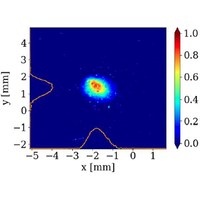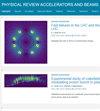Acceleration of uranium beam to record power of 10.4 kW and observation of new isotopes at Facility for Rare Isotope Beams
IF 1.8
3区 物理与天体物理
Q3 PHYSICS, NUCLEAR
Physical Review Accelerators and Beams
Pub Date : 2024-06-17
DOI:10.1103/physrevaccelbeams.27.060101
引用次数: 0
Abstract
The Facility for Rare Isotope Beams (FRIB) is a major nuclear physics facility for research with fast, stopped, and reaccelerated beams that was successfully commissioned in May 2022. A key capability of FRIB is the production of an acceleration of the uranium beam, but this capability requires the facility to work at the design limits of the lowest charge-to-mass ratio and the highest power density on the beam intercepting devices. This paper presents techniques for overcoming the significant challenges in accelerating the uranium beam, culminating in the demonstration of 10.4 kW on target, and the discovery of three new isotopes. The high-power uranium beam enabled us to produce and identify , , and , within the first 24 h of operation. The successful uranium operation at FRIB sets a new record for accelerated uranium beam power above 10 kW and opens a new avenue of research with rare isotopes.

将铀束流加速到创纪录的 10.4 千瓦功率,并在稀有同位素束流设施观测到新同位素
稀有同位素光束设施(FRIB)是利用快速、停止和再加速光束进行研究的主要核物理设施,于 2022 年 5 月成功投入使用。FRIB 的一项关键能力是产生加速铀束,但这一能力要求该设施在最低电荷质量比和最高功率密度的束截获装置的设计极限下工作。本文介绍了克服铀束加速重大挑战的技术,最终展示了 10.4 千瓦的目标功率,并发现了三种新同位素。高功率铀束使我们能够在运行的头 24 小时内产生并确定 G88a、A93s 和 S96e。FRIB 的成功铀运行创造了加速铀束流功率超过 10 千瓦的新纪录,为稀有同位素研究开辟了一条新途径。
本文章由计算机程序翻译,如有差异,请以英文原文为准。
求助全文
约1分钟内获得全文
求助全文
来源期刊

Physical Review Accelerators and Beams
Physics and Astronomy-Surfaces and Interfaces
CiteScore
3.90
自引率
23.50%
发文量
158
审稿时长
23 weeks
期刊介绍:
Physical Review Special Topics - Accelerators and Beams (PRST-AB) is a peer-reviewed, purely electronic journal, distributed without charge to readers and funded by sponsors from national and international laboratories and other partners. The articles are published by the American Physical Society under the terms of the Creative Commons Attribution 3.0 License.
It covers the full range of accelerator science and technology; subsystem and component technologies; beam dynamics; accelerator applications; and design, operation, and improvement of accelerators used in science and industry. This includes accelerators for high-energy and nuclear physics, synchrotron-radiation production, spallation neutron sources, medical therapy, and intense-beam applications.
 求助内容:
求助内容: 应助结果提醒方式:
应助结果提醒方式:


